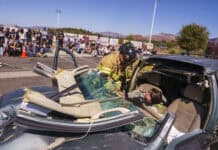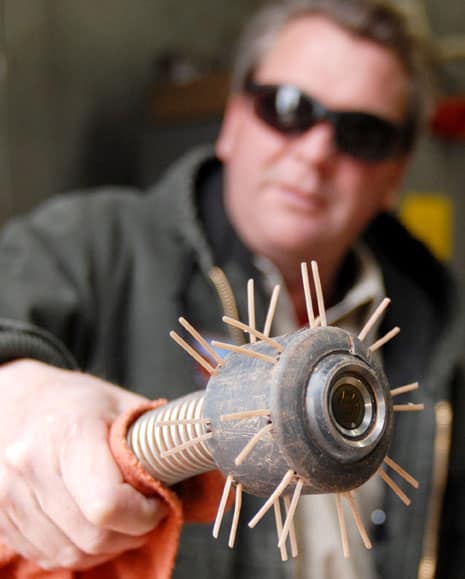Wastewater and sewers aren’t the most appetizing of topics, but they’re the most expensive items on Sedona’s financial menu.
In response to a request from the Sedona Red Rock News, candidates for Sedona City Council offered their thoughts on the subject:
What are the environmental and financial risks in the city’s current drainage and sewer infrastructure?
* Incumbent City Coun-cilman John Bradshaw: “Environmental issues for sewer are spills, blockage and pump failures which could, if not maintained, end up in Oak Creek or our water supply.
“Flood drainage also is a way for pollutants to end up into our water supply, and damage to personal property can result if not addressed properly.
By Susan Johnson
Larson Newspapers
Wastewater and sewers aren’t the most appetizing of topics, but they’re the most expensive items on Sedona’s financial menu.
In response to a request from the Sedona Red Rock News, candidates for Sedona City Council offered their thoughts on the subject:
What are the environmental and financial risks in the city’s current drainage and sewer infrastructure?
* Incumbent City Coun-cilman John Bradshaw: “Environmental issues for sewer are spills, blockage and pump failures which could, if not maintained, end up in Oak Creek or our water supply.
“Flood drainage also is a way for pollutants to end up into our water supply, and damage to personal property can result if not addressed properly.
“These two items have been the city’s largest expenditure and will continue to be top priorities for new projects and maintenance.”
* Candidate Suzanne Chaffee: “Sewer system breaks could leak into our sidewalks, roads, and homes at huge expense and the city might not have the funds to cover needed upgrades.”
* Candidate Cliff Hamilton: “Additional sewer extensions within the city are not required and are more of a political/financial issue than an environmental one.
“Sedona has taken advance connection fees from residents on the promise that they will eventually be connected to a city sewer system.
“The city is now faced with the probability that a number of those pre-paid homes will not be connected in any reasonable future, if ever, and will likely have to refund many of those advance fees in addition to potentially assuming the obligation of maintaining private systems.”
* Candidate Marc Sterling: “[Current] environmental risks are low since the city has installed sewer to all of the priority areas that were potential contaminants of Oak Creek and its associated watershed.
“I don’t foresee any looming financial risks since the bonds for the sewer were refinanced at better interest rates a few years ago and the operations of the sewer have a dedicated revenue stream.”
* Candidate Dan Surber: “Environmentally, we need to ensure that older septic systems are adequate and eventually connected to city sewer and we also need to continue repairs and improve drainage detention and metered distribution to alleviate street deterioration and soil erosion.”
What is your estimate of future costs related to sewers and drains over the next five years?
* Bradshaw: “The city currently has no approved expenditure plan for the collection systems beyond the Chapel, Vista Bonita and Harmony/Windsong projects.
“Chapel sewer is about $9 million, Vista Bonita and related chapel drainage is about $0.8 million and Harmony-Windsong drainage is about $2.1 million.
“Maintenance work for the sewer system ranges from $1 million to $1.5 million per year.
“Storm system maintenance ranges around $0.2 million to $0.4 million per year.”
* Chaffee: “To get all the developments on sewer, including Broken Arrow, Chapel, Saddle Rock, Cibola Hills/Uptown, Sky Mountain, and Casa Manana areas, it could cost in the $20-million range.”
* Hamilton did not answer this question.
* Sterling: “Major storm drainage projects for the Harmony area and the Chapel area in the amount of $1.6 million and nearly $3 million is needed for the storm drainage repairs for the Chapel and Harmony areas.”
* Surber: “[The city approved] $17 million with approximately $8 million for Chapel sewer connection and $3 million to $4 million for drainage improvement in the Chapel and Harmony areas, and $6 million for improvements on Hwy. 179.”
If elected, from what source will you allocate funds to pay for those future costs?
* Bradshaw: “Sewer fee revenues, sewer reserve account, general and capital funds, and lastly general obligation bonds.”
* Chaffee: “By helping make Sedona a green model for the world we will have more sales tax revenues and therefore we might not need to resort to an excise tax bond.”
* Hamilton: “Individual homeowners may continue to be charged a sewer ‘connection’ fee plus monthly charges in both cases to fund the system as well as the creation of special improvement districts to achieve a stable and sustainable sewer system in areas that may choose that option.”
* Sterling: “Currently, 1.3 cents of our sales tax income [per dollar] is dedicated to sewer funding.”
* Surber: “Continue to use a percentage of sales tax along with current user fees and future new connection fees.
“Also, I believe there could be some revenue generation gained from the proper use of the city’s treated wastewater.”
How much of the city’s investment in sewers and drains should focus on new infrastructure and how much on repair and maintenance of existing operations?
* Bradshaw: “There’s still a new infrastructure to do, so, 70 percent new and 30 percent maintenance.
“Our goal should be to reverse these numbers over the next five years with an emphasis on maintaining what we have.”
“Expansion at this point is a council prerogative,” Bradshaw said.
* Chaffee: “We should focus approximately 70 percent on new sewer and 30 percent on older sewer lines needing reparations, but start with the oldest or faultiest first.”
* Hamilton: “Whether it’s streets, sewer systems, parks or other city facilities, taking care of existing infrastructure must come before building more.”
* Sterling: “There’s not likely to be much addition of new sewer infrastructure after the Chapel area is finished, [but] maintenance is critical.”
* Surber: “Currently, 73 percent of the city of Sedona has connected or connection is available to the sewer. Our primary focus should be on maintaining existing infrastructure with any extension being secondary.”
Susan Johnson can be reached at 282-7795, Ext. 129 or e-mail sjohnson@larsonnewspapers.com



















